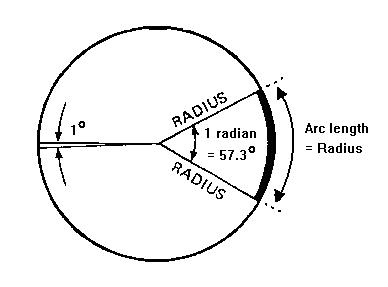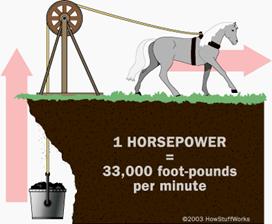
Figure 12-1: Radian and degree
Image ©2005 DiscoverHover
| NAME | DATE |
Before taking a closer look at how torque, work, and power are involved in an engine, we need formal definitions of work and power. When we think of the words ‘work’ and ‘power’, many different meanings may come to mind. Work is often thought of as physical labor or something we get paid to do. Common meanings for power include the amount of energy something can produce, the electricity that we get out of electrical sockets; and a synonym for strength. According to physics, work and power have specific definitions. Let’s now learn those definitions.
When a force acts to move an object, work is done. This is written asWork = Force × Distance force acts
When you push something, how much work you do on it depends both on how hard you push it and how far you push it. In the Imperial system, work is measured in foot pounds (ft-lb). The equivalent unit in the SI system is the Newton meter (N-m), also known as the Joule (J). This is named after James Prescott Joule, a scientist who lived in the 1800s and made important discoveries in the field of thermodynamics, which is the study of heat, work, and other forms of energy.
| Example 1: You pull a hovercraft with a force of 66 N [14.8 lb] along a sandbar that is 5 m [16.4 ft] long. How much work is done on the hovercraft? Solution: Work = Force × Distance In pulling the hovercraft along the sandbar, you performed 330 N-m [243 ft-lb] of work on the hovercraft. |
|
Example 2: Your hovercraft weighs 266 N [60 lb] and is sitting on the floor. You need to lift it up onto two 1 m [3.28 ft] high workhorses so the skirts can be changed. How much work is required to lift the hovercraft? Solution: Work = Force × Distance It will take 266 J [196.8 ft-lb] of work to lift the hovercraft onto the horses, since 1 J is 1 N-m. |
Remember that torque can be thought of as a turning or twisting force. When we talk about work done by a torque, we multiply the torque by how much it turns, or the angle through which it rotates.
Work = Torque × Angle through which torque acts
To turn an object, you exert a torque on it. How much it turns is given by the angle it turns through. For example, if you tighten a screw so that the screw twists one full revolution (360°), you exerted a torque on that screw through an angle of 360°.
Before we can do some examples, we need to know what units are used to measure angles. We are most familiar with angles in terms of degrees. When doing calculations with angles, however, we need to use a unit called radians. 1 radian is equal to about 57.3°. Why would anyone want to make a new unit for angles that is equal to 57.3°? Look at the figure of the circle. It shows both an angle of 1° and of 1 rad (short for radian). You can see that the angles cut out triangular sections of the circle. The length of the portion of the circle contained in a triangular section is called the arc length. It turns out when the angle is 1 rad, the arc length is equal to the radius of the circle! Another interesting fact is that 1 full revolution (360°) is equal to 2π radians. Half of a revolution (180°) is therefore equal to π radians. Remember that π is close to 22/7.

Figure 12-1: Radian and degree
Image ©2005 DiscoverHover
Example 3: Solution: Work = Torque × Angle Turning the propeller 3 revolutions will require 264 N-m [194.8 ft-lb] of work. |
Now we need a way to define power. Power is the rate at which work is performed, or the amount of work done per unit time.
Power = Work / Time
Go back to the example where you pull the hovercraft along the sandbar. You could take 10 seconds to pull the craft that far, or you could pull really slowly and take 10 minutes. Either way, you’re still doing the same amount of work. Your power, however, is greater the faster you pull it. In the Imperial system, power is usually measured in horsepower (hp). In the metric system, joules per second (J/s) has another name, the watt (W). This was named after James Watt, an engineer who made important contributions to the development of the steam engine. Interestingly, James Watt invented the term horsepower. It is said that he measured a pony producing 22,000 foot pounds of work in a minute while pulling buckets of coal out of a mine. He thought that horses were about 50% more powerful than a pony, so he increased it to 33,000 foot pounds per minute, or 550 foot pounds per second. This is also equal to 746 watts in SI units.

Figure 12-2: The Meaning of Horsepower
Image from www.howstuffworks.com
To get power from torque, multiply torque by the angle it acts through, then divide by the amount of time it takes. This angle per unit time is called an angular velocity. With engines, this is commonly called revolutions per minute (rpm). If we multiply torque by angular velocity, we get power. We often know the horsepower of an engine, but also want to know how much torque it can produce. We now have a simple formula for this.
Power = Torque × Angular velocity
- or -
Torque = Power / Angular velocity
When doing these calculations, it is essential that all the values are in similar units. This often leads to some unit conversions to ensure they are similar.
Example 4: Solution: 2500 revolution/min × 2 × π rad/revolution / 60 sec/min = 261.8 rad/s Convert horsepower to either foot pounds per second or watts, depending on whether we’re using Imperial or SI units. 12.5 hp × 550 ft-lb/s / hp = 6875 ft-lb/s With power in watts or in foot pounds per second and angular velocity in radians per second, calculate the torque produced. Torque = Power / Angular velocity When the Discover Hover One’s engine runs at 2500 rpm, it will produce 35.3 N-m [26.3 ft lb] of torque. |
Most of the time, some of the power delivered to a system is lost to friction and there are other losses as well, so the actual output power is less than the power input. A convenient way to describe the efficiency of a system is to calculate the output as a percentage of the input power, according to a formula.
Percentage efficiency = Power input / Power output × 100
Example 5: Solution: Power input = Work input / Time Power output = Work output / Time Percent efficiency = Power output / Power input × 100 You are 67 percent efficient in pulling this machine over this surface. |
Quiz Questions.
Answers are in the Answer Key
| ©2005 World Hovercraft Organization All rights reserved. Copies of this Curriculum Guide may be printed for classroom use exclusively by DiscoverHover registered members. This Curriculum Guide and all materials contained in the DiscoverHover web site are protected by copyright laws and may not be reproduced, republished, distributed, or displayed on any other web site without the express prior written permission of the World Hovercraft Organization. |